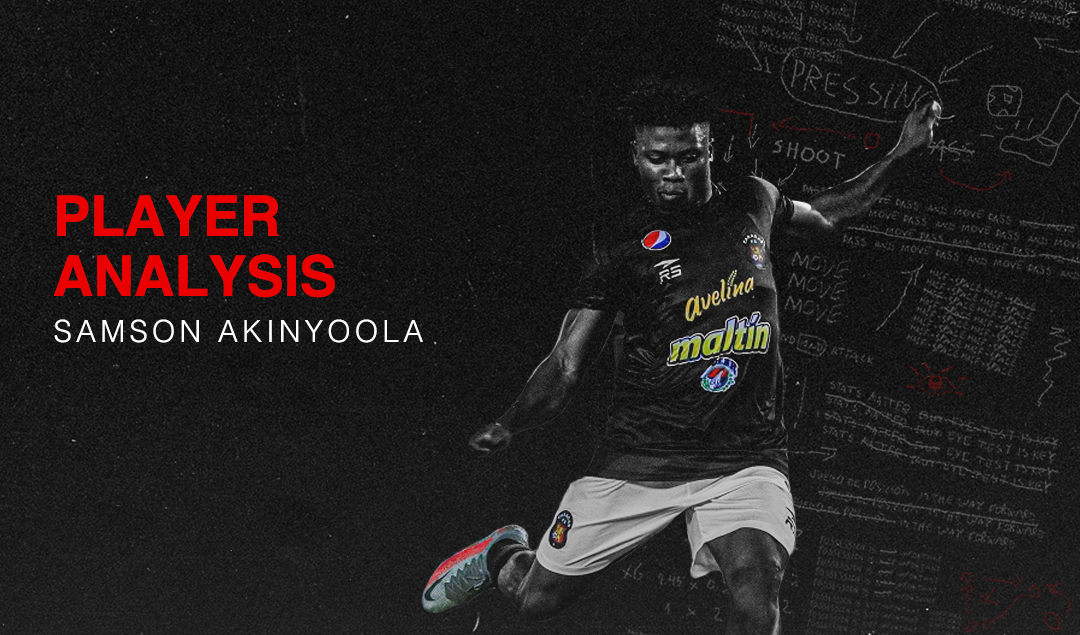Player Analysis: Samson Akinyoola
Goals garner attention; this is nothing new within the footballing ecosystem. Good goals get clicks, whilst good goalscorers get famous; with this in mind, it is no surprise that they are the most lauded and sought after commodity in football.
Increasingly teams are willing to risk financial failure on forwards who play at a level or two below what they could, yet have the “scoring touch” and the numbers to back it up. Evidence for this strategy’s success can be seen clearly in Alfredo Morelos, Moussa Dembele and Terem Moffi.
There are a plethora of forwards who have and continue to play at a level below they should. Some in this camp play in the peripheries of European football like Rauno Sappinen and Dembo Darboe, whilst some are ready to break the glass ceiling into the elite’s inner circle like Porto’s Luis Diaz, Genk’s Paul Onachu, and FCK’s Jonas Wind.
This is far from just a European occurrence, as the poster boy for this phenomenon is likely Flamengo’s Gabigol. Suppose we head slightly north of Brazil to Caracas, Venezuela. In that case, we encounter a 21-year-old Beninois striker who, after just a solitary year in the capital, is performing at a level beyond his FUTVE competition.
Samson Akinyoola’s story doesn’t start in Venezuela; rather, in Nigeria and later Slovakia; however, it is in the South American nation where he has found success and started his journey towards a successful career in Europe.
Akinyoola’s story is unique, as is his once club FK Senica; however that is not what you’re here to read about, so let’s begin to analyse his game.
Position and Role
For the most part, Akinyoola plays as the centre-forward in Caracas FC’s 4-2-3-1 with an extremely potent and talented three behind him, which includes Richard Celis and Jorge Echeverria, two players, who in their own right are deserving of moves to one of South America’s top leagues or across the Atlantic.
Despite spearheading the attack, Akinyoola is afforded plenty of space to roam, which fits the tactical setup given the high and wide wingers who, when required, can play like outside 9s, whilst Akinyoola slips deep into more of a 10.
This is seen in the heat map below, where we see Akinyoola’s influence and activity drop down to the centre circle. When we split the pitch into its five sections, we can see that Akinyoola, as expected, is most active in the central section, with a slight preference for the left half-space and left-wing over the right, which is expected given that his right is his stronger foot.
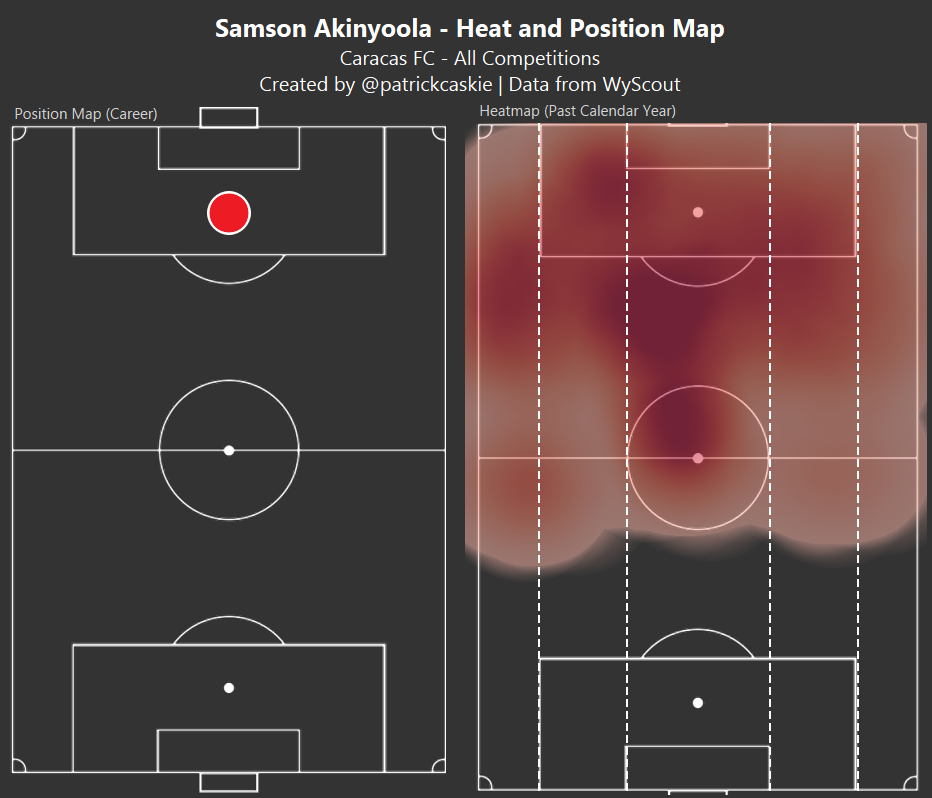
However, as we will discuss later, his left is used for far more than just standing. The most significant hotspot is found just to the left of the semi-circle on the edge of the box, a natural favourite for most right-footed strikers, given the suitable angle for a shot.
Statistical Overview
Before we delve into any specifics, let’s have a look at how Akinyoola compares to his fellow STs in Venezuela in a general sense.
The graphic below is reasonably easy to comprehend; the higher the percentile value, the higher Akinyoola corresponds to the sample size, which in this instance is all FUTVE strikers with over 1000 minutes in the Past Calendar Year, my minimum threshold for any squad player.
The sea of red present below indicates that Akinyoola is an elite forward in almost every aspect, albeit his defensive engagement is low, but that is expected from such an attacking force on a possession-dominant side.
When we look at the attacking section, Akinyoola finds himself in the 75th+ percentile for all goalscoring-related metrics. His most impressive output within this section is undoubtedly his non-penalty goals p90 and touches in the box p90, two essential facets for any striker worth his salt.
Finally, it is necessary to highlight Akinyoola’s xG over-performance, roughly +23%, suggesting that either Akinyoola has run hot in the past 12 months, or he is a cold, calculated finisher; in truth, it’s likely both are valid to a certain extent.

As mentioned earlier, goals are the central ambition of any striker; however, when it concerns Akinyoola’s performance for Caracas FC, his ability to during both build and link-up play is perhaps his trump card. So cast your eyes to the passing section in the graphic above and marvel at the Akinyoola’s achievements, not a single metric below the 62nd percentile, with four above the 80th percentile.
Even if Akinyoola is not finishing off moves, he has likely played a considerable role in creating the said chance. Inherently maintaining this sort of output is simpler in Venezuela compared to Brazil, Argentina, or Europe’s top 15 leagues; however, it remains no easy feat, and one I would back Akinyoola to replicate to some extent, unlikely entirely, upon his next move.
Shooting, Goalscoring, and Decisions
The section above has shown you that Akinyoola’s is a goalscorer above anything else, so let’s have a look at where, the types, and areas of improvement when it comes to his shooting and, by extension, goalscoring. The graphic below shows all of Akinyoola’s shots from the 2021 season plotted, with both colour and size marketing chance quality.
It is abundantly clear that Akinyoola is a penalty box finisher, with most of his shots being taken from between the penalty spot and penalty box.
This is further corroborated when you look at the two lines, which show both the average height and width of his shot, intersecting to the left of the centre circle and a few feet inside the penalty box, not precisely the opportune shooting spot, but not entirely the worst.
Despite his average shot placement, most of his goals are located much closer to goal, which is expected given the natural increase in chance quality as you get closer to goal. This can be explained partially by his activity in the air, as you will rarely attempt a header from behind the penalty spot, as such beefing up his attempts from close to goal.
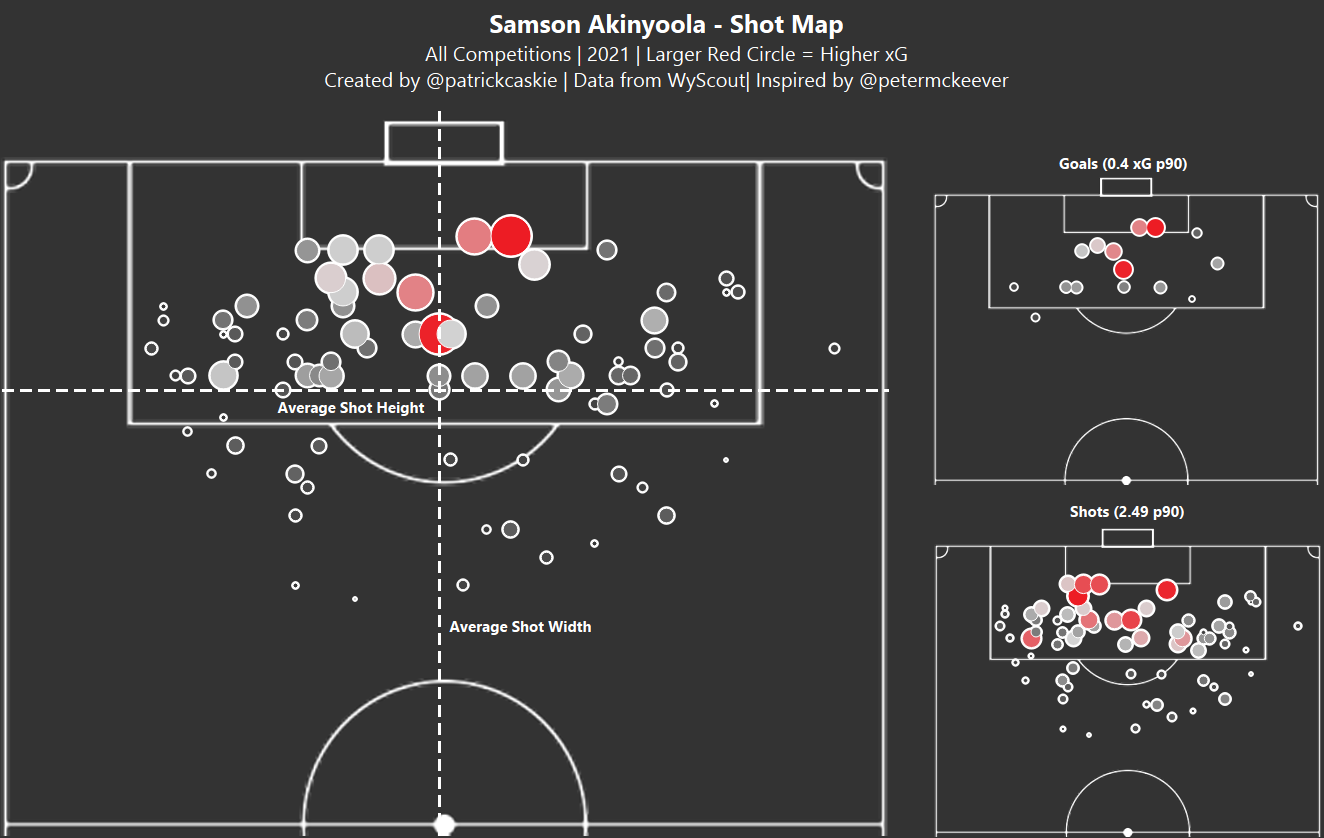
One concern that is evident when you consider the colour of each circle is that Akinyoola often spurns high-quality chances, with a cluster of 5 or 6 red circles close to the goal. Luckily this season, he has supplemented it by scoring from low-quality chances. This is far from a sustainable trend and is unreplicable in a league of higher quality.
I previously mentioned that Akinyoola is effective in the air; with this in mind, let’s look at how Akinyoola scores his goals. The graphic below shows us Akinyoola’s goal share split between both feet and his head.
The diversity in goalscoring “instruments” is impressive and exciting. Akinyoola is not over-reliant on his “stronger foot”. His aerial presence will force defenders to track him closely at corners and from crossing situations, which is positive for his teammate.
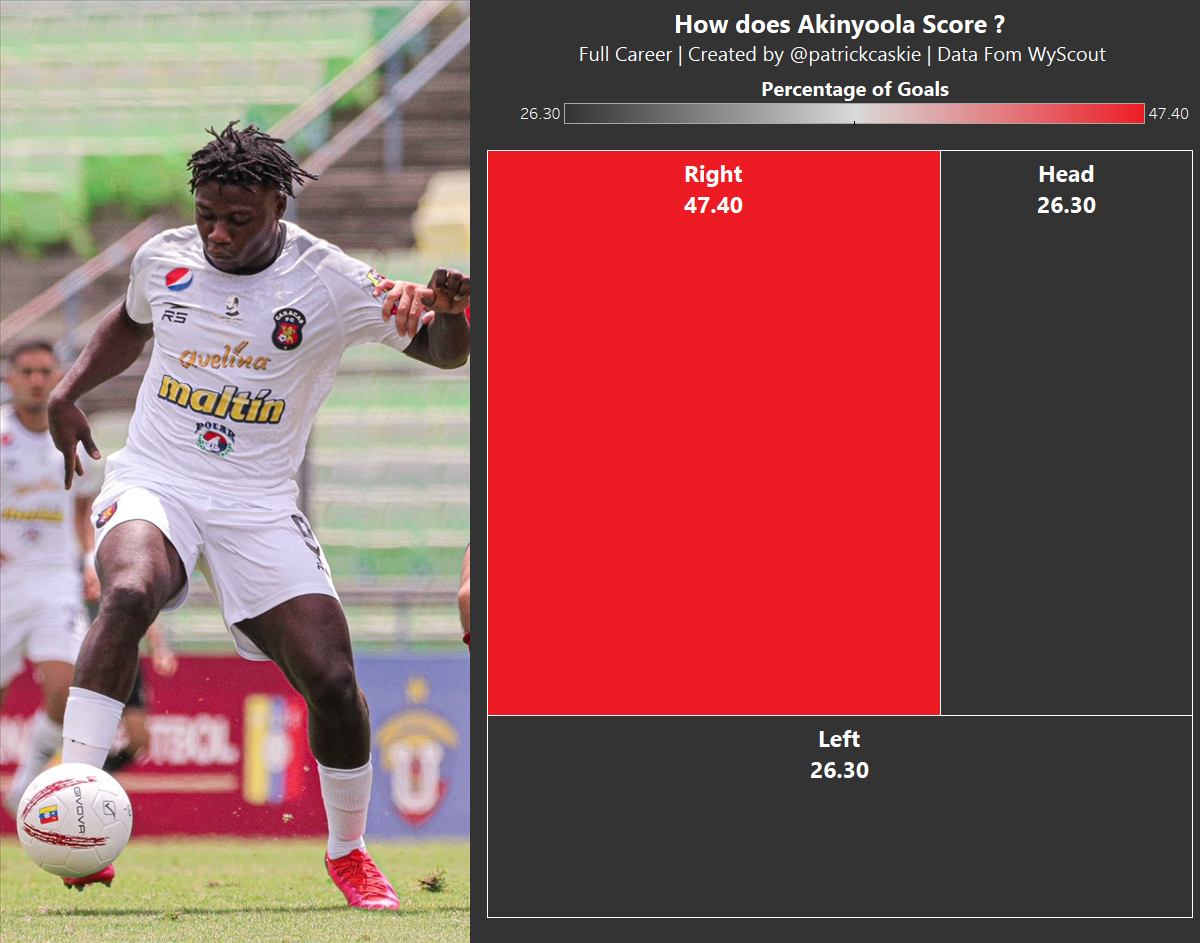
We’ve looked at where and how Akinyoola scores; let’s now analyse a few of his goals from this season, with an eye on movement and finishing. A common origin of Akinyoola’s goals come in the form of runs in behind the CBs.
The centre-forward often plays on the shoulder of the deepest CB. Whenever this defender is somewhat progressive, Akinyoola takes advantage, as all his teammates need to do is play a suitable through ball, and he will do the rest.
The image below is a perfect example of this situation, as here we see Akinyoola get inside his man’s shoulder, presenting an obvious path to goal, which his teammate identifies.
Akinyoola picks the ball up on the left side of the box and, with his weaker left foot, dispatches it into the opposite corner with precision.
This finish requires skill of the highest order given the angular superiority the goalkeeper has over Akinyoola, regardless of whether he manages to thread the needle or not. Funnily enough, his second in this match was effectively a carbon copy showing scope for replicability.

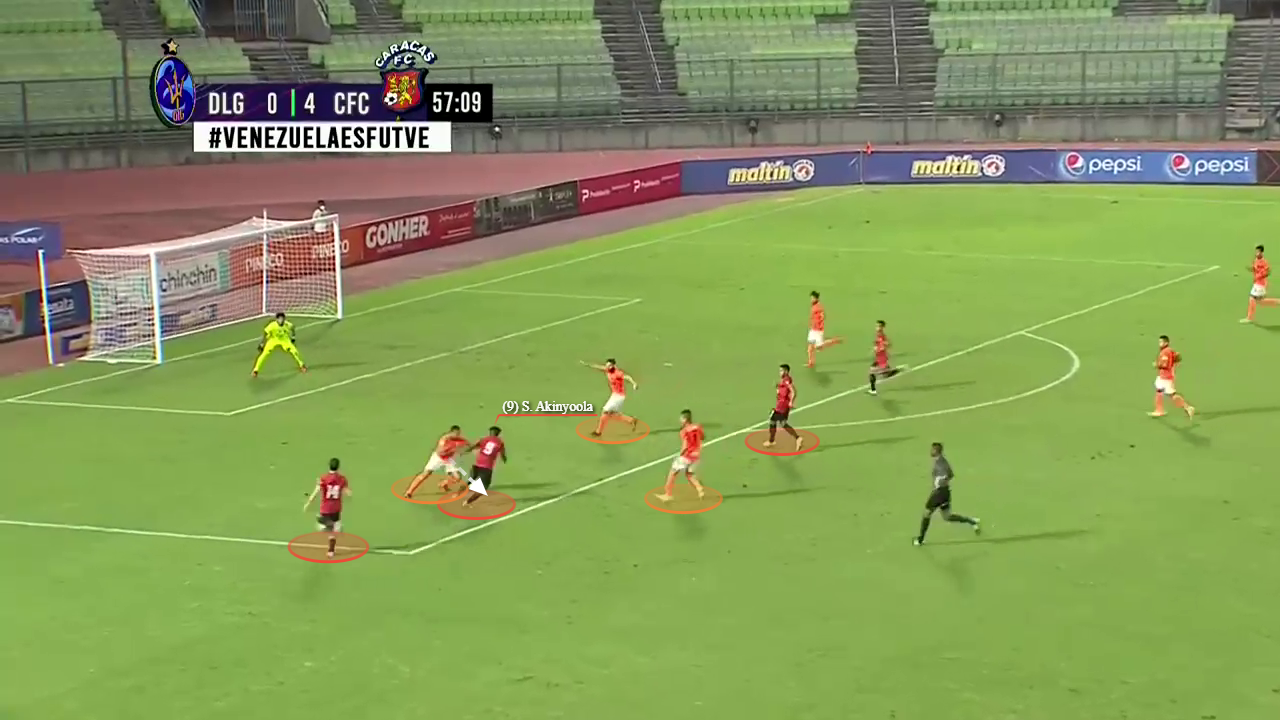
Another example of Akinyoola’s ability when given space to run into is found below. Here we see Akinyoola again get inside of his man, this time, a lofted header plays him in but still controls it quickly and gets in front of his man.
Again he is presented with a slightly tricky angle; however, this time, it’s due to proactive goalkeeping as opposed to Akinyoola’s position. Regardless, he slots it past the GKs right hand and into the bottom left-hand corner, again showing off his composed finishing after breaking away from the chasing defensive pack.
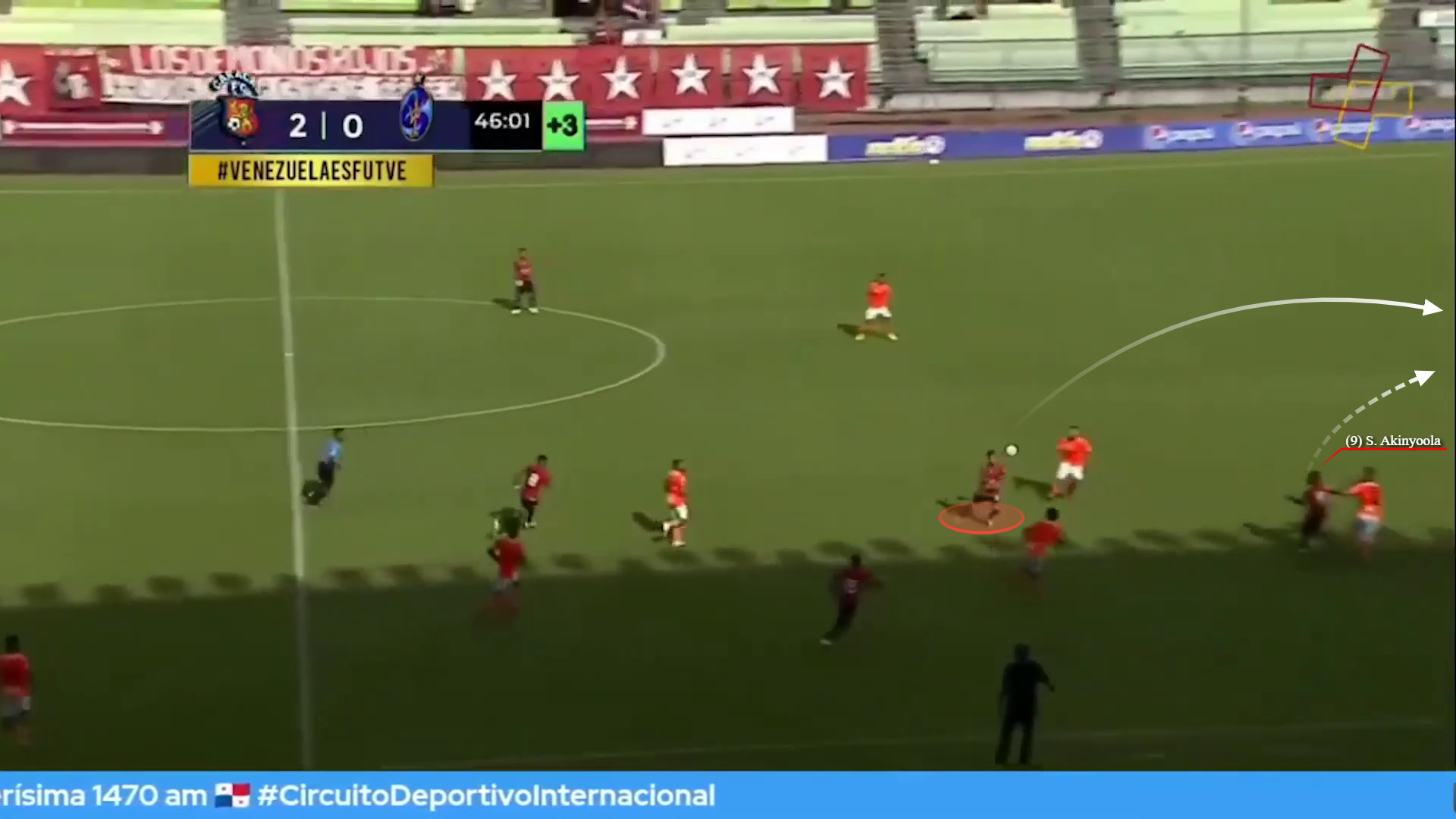
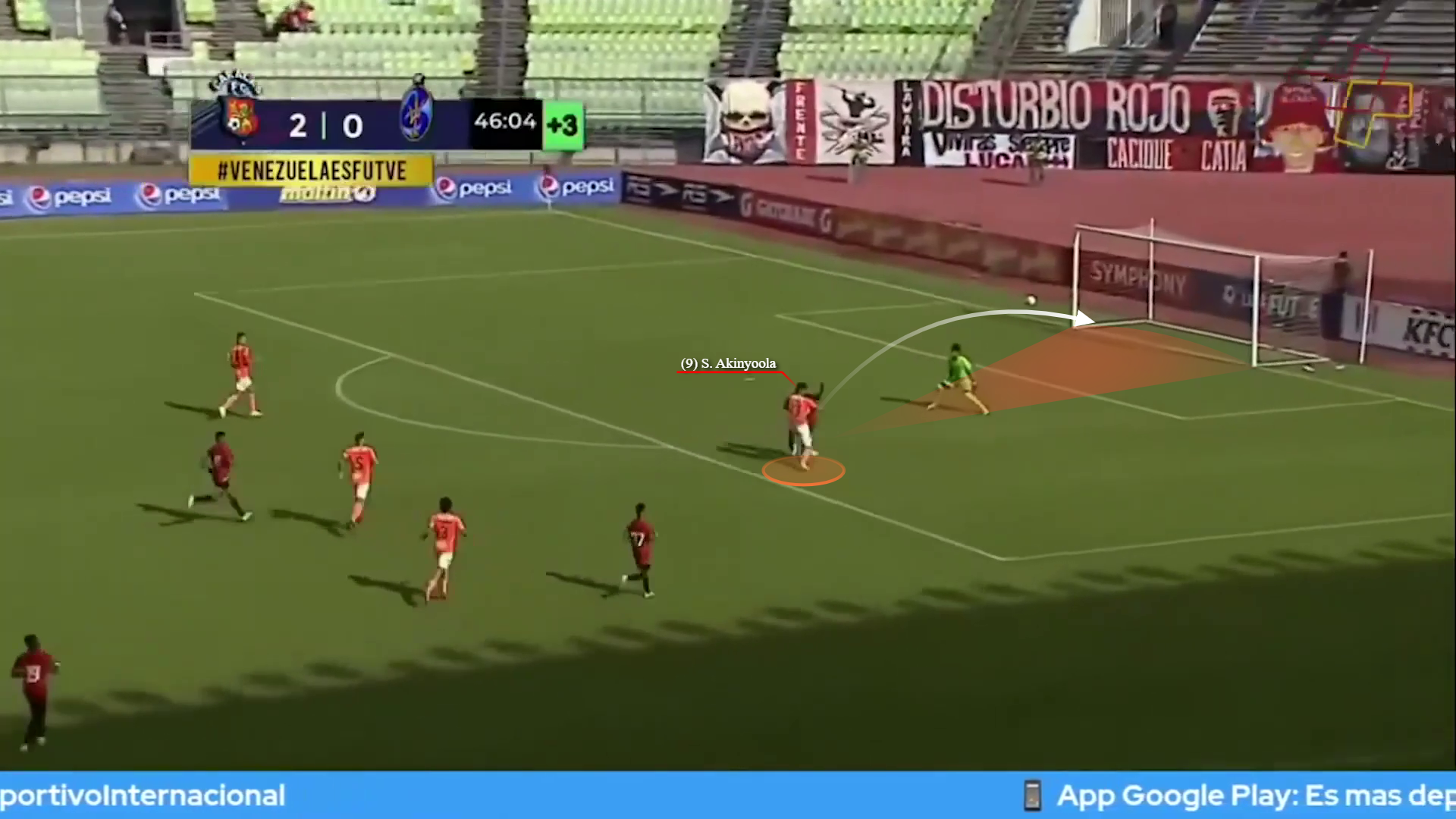
Despite excelling when given space to run into, Akinyoola is also an effective option in tight spaces, and it’s here where he can show off his link play which will be discussed at length later.
The first example, which can be seen below, doesn’t involve Akinyoola deferring to any teammates, instead, here we see him navigate past three defenders inside a very cramped penalty box, showing off close control and flexible hips, before placing the ball in the net with what can only be described as a top-poke.
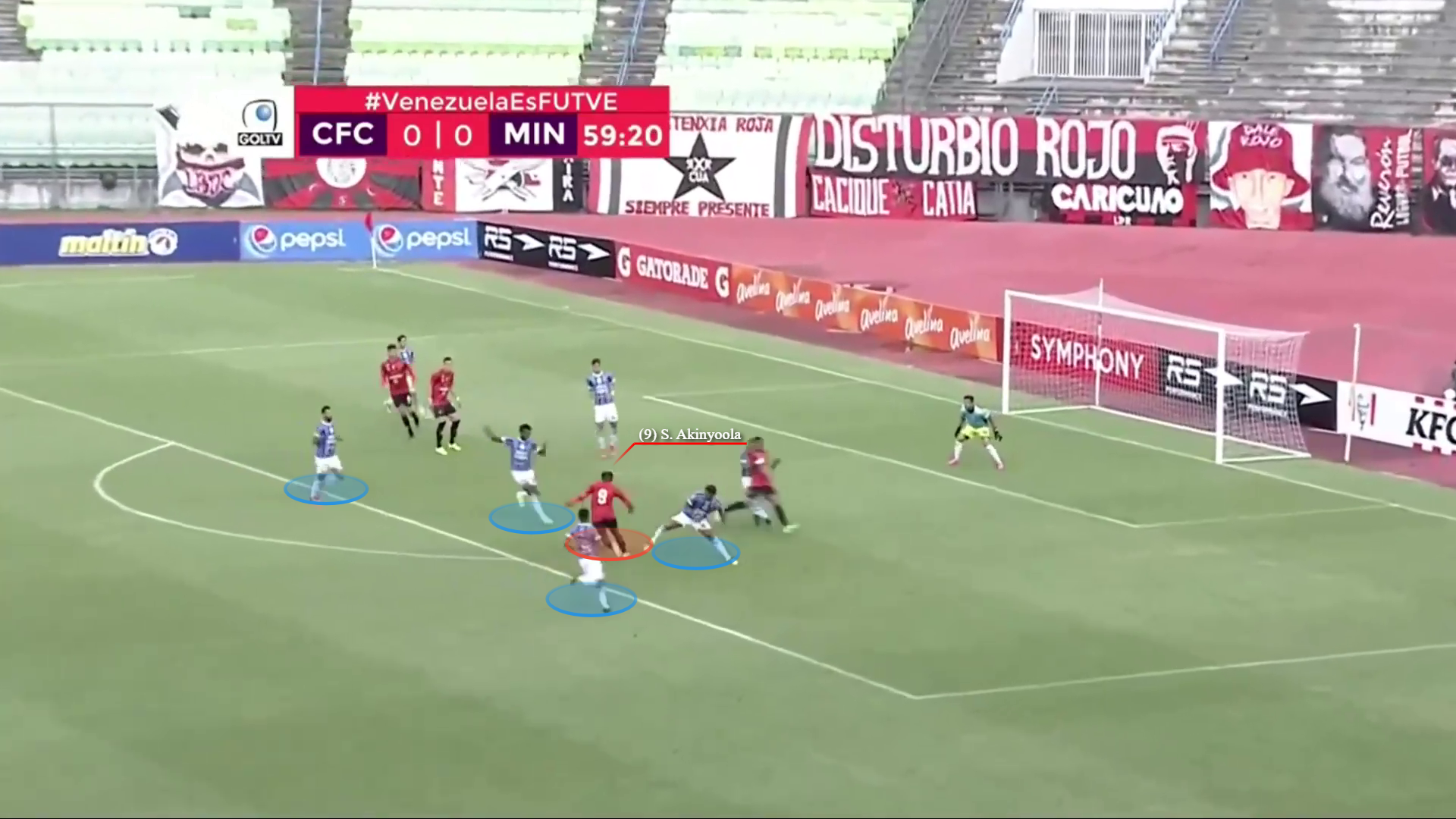
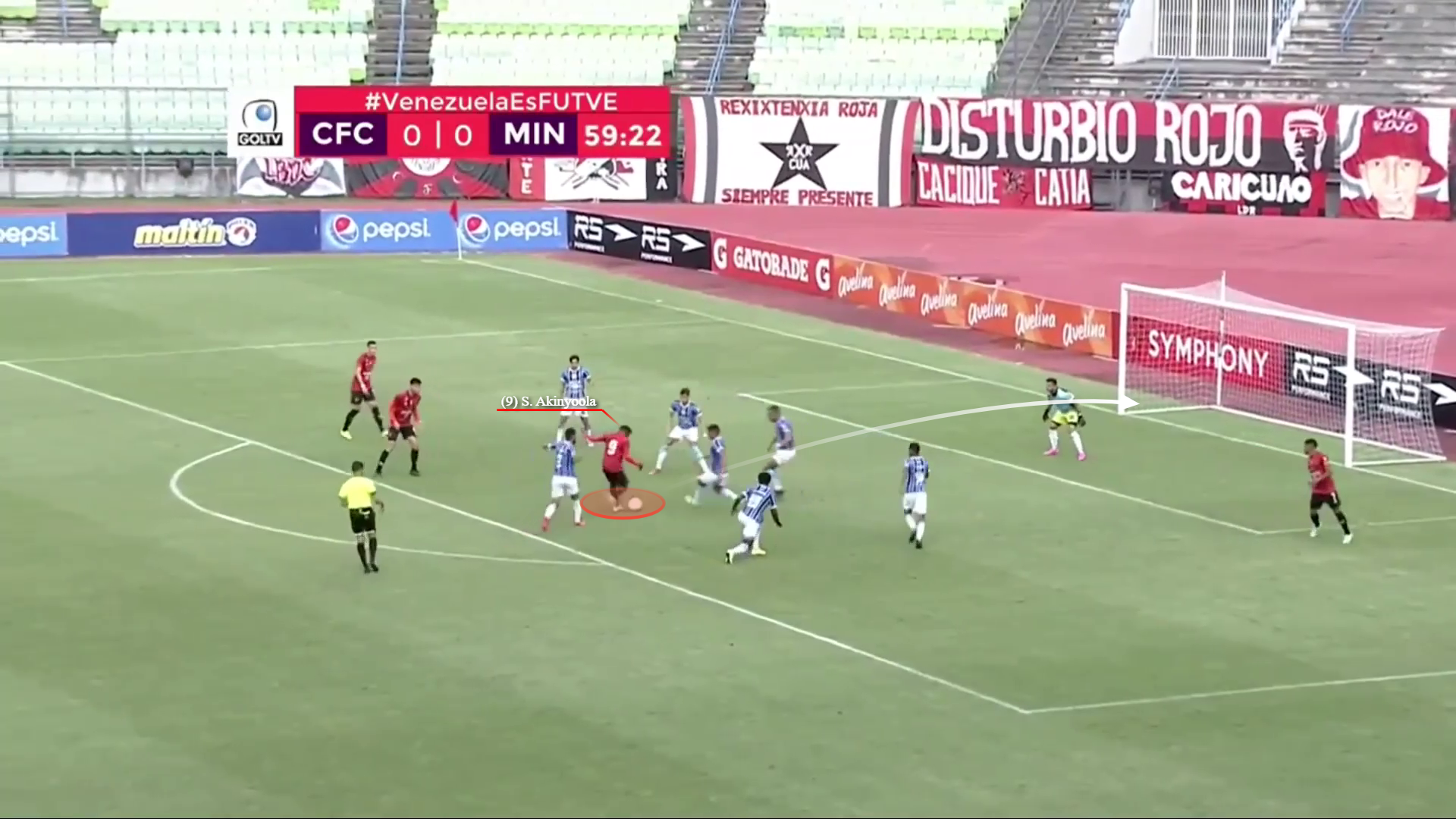
If the previous example should off Akinyoola’s ability to go at it alone, the example below shows his effectiveness when interplaying with teammates. Here, Akinyoola receives the ball whilst his body sideways to goal with two defenders actively marking him.
He intelligently plays a backheel to his teammate, who is open due to the aforementioned double-team; after, he immediately heads towards the box to offer an option for a one-two.
Akinyoola is played in, and the one-two is completed. He finds himself in acres of space; in turn, he easily slots the ball above the goalkeeper into the roof of the net, once again, with his left foot.
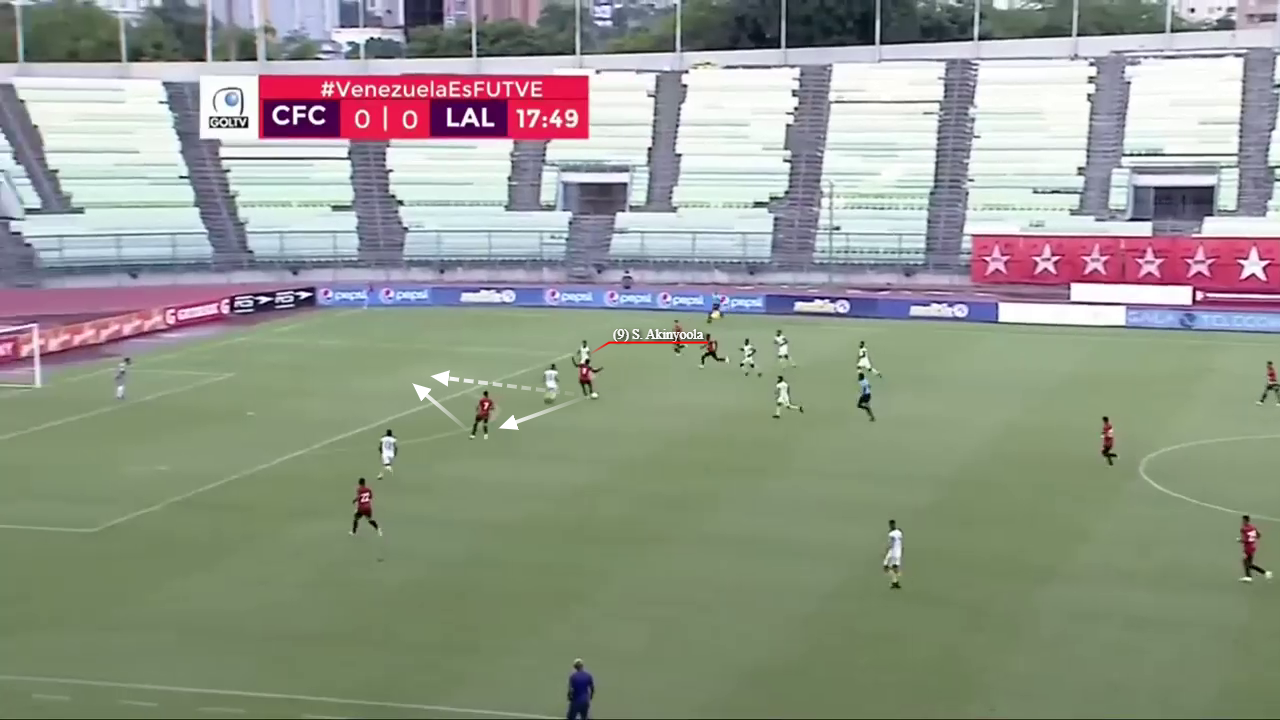
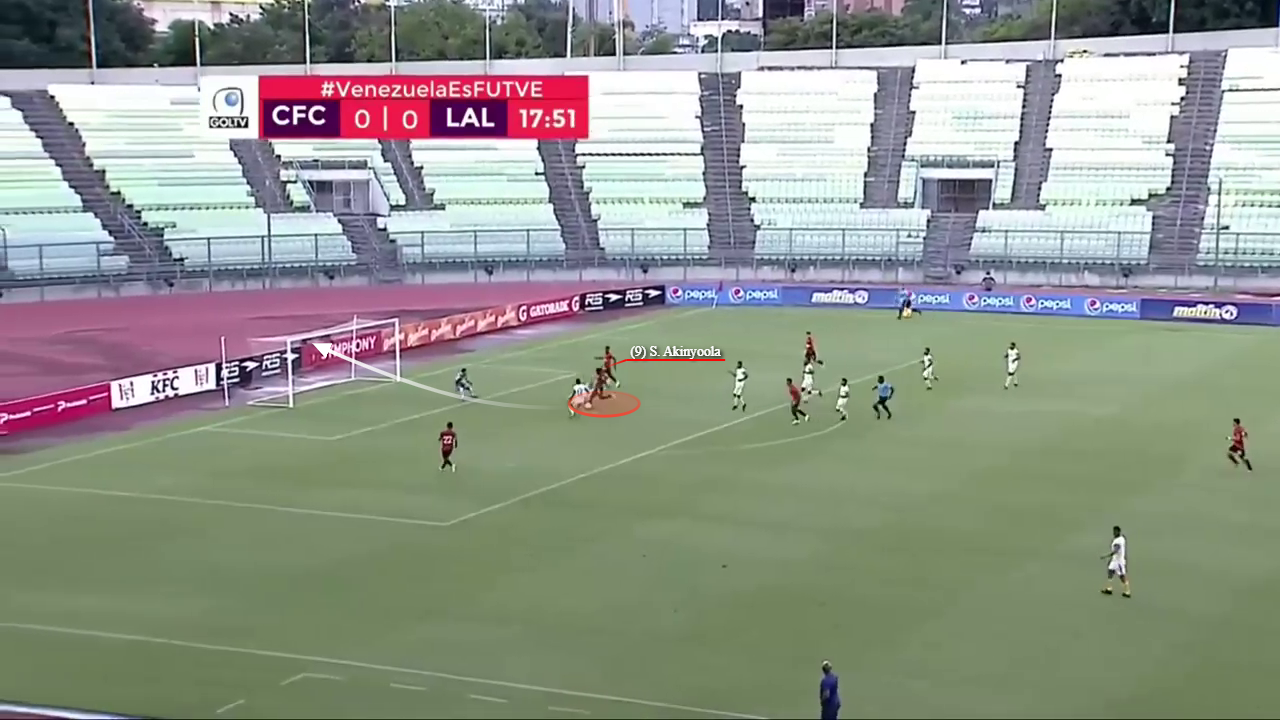
Finally, let’s look at an example of Akinyoola’s heading ability. In all honesty, his heading ability is not spectacular; he is neither supremely accurate nor a generator of much power, but what he does have is excellent positioning, which resigns most of his opportunities to simple tap-ins.
Additionally, Akinyoola is neither the tallest nor highest jumper. Still, he has that Morelos-Esque grit which sees him somehow compete and often come out on top against taller, better-equipped defenders.
Below is an example of his top positioning, here he slips his marker at the back post and heads in a lofted delivery into what is effectively an open net, a testimony to his under-the-radar late movement, an invaluable trait.
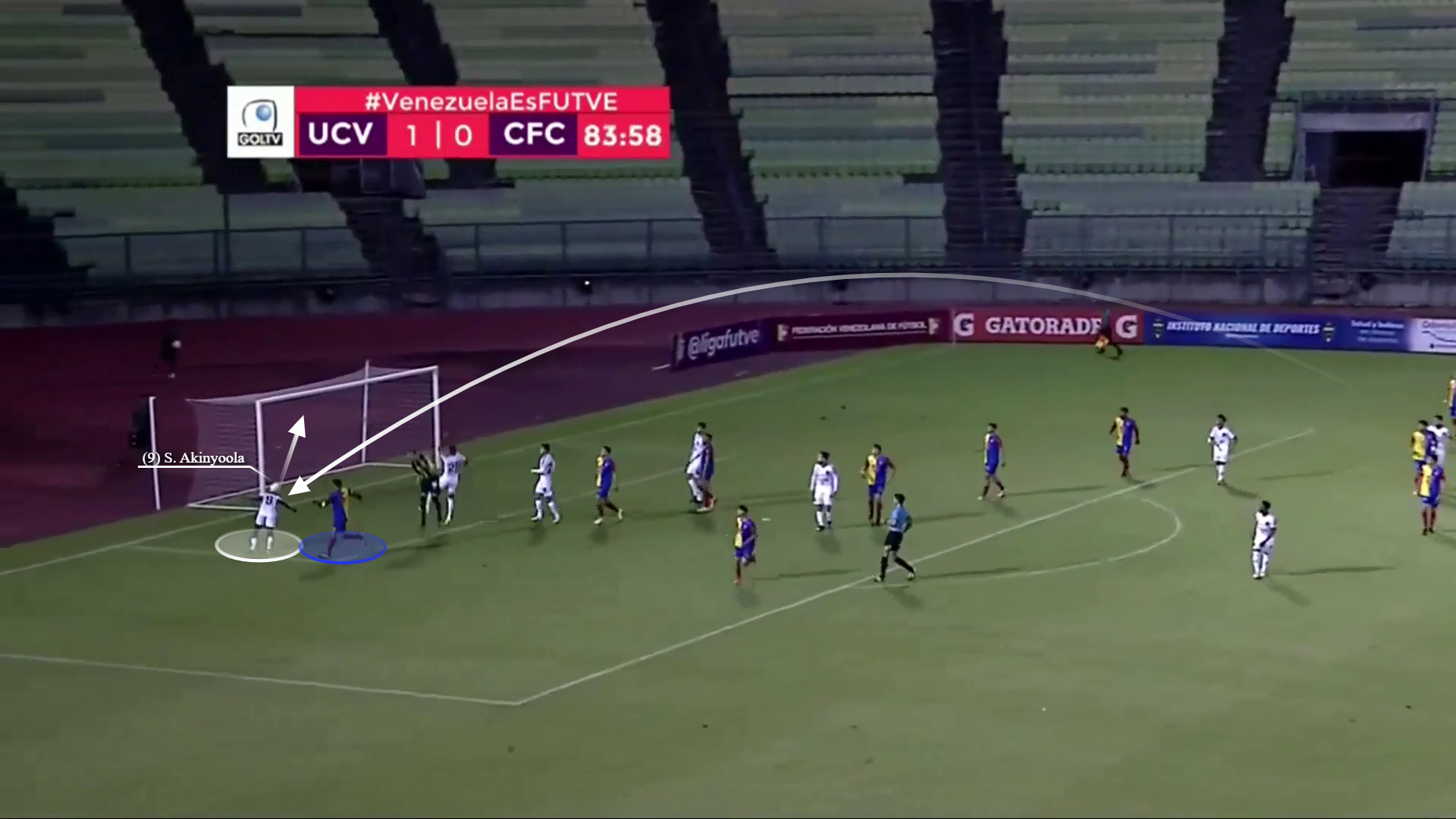
Undoubtedly, Akinyoola is a talented goalscorer; you can’t argue with the numbers or the examples above; however, my most significant criticism in traditional striking capacity is that his shot selection is underwhelming.
This is characteristic of most young forwards, and as such, is not the biggest deal, as young forwards, more so than anyone else, are eager to get on the score sheet and make the most of their first steps.
It’s an interesting phenomenon as his raw numbers don’t fully corroborate my assertion as his xG pShot and Shots p90 are both decent to good. Yet during my time watching him, I felt that he often forced shots that were not there or took on a shot whilst a teammate was in a far better position.
The former can be seen in the image below, as Akinyoola decides not to take the shot first time despite the space, instead, taking a few touches before mustering an attempt despite the presence of two defenders in front of him. This is far from unsolvable; however, it is a quirk that he should deal with sooner rather than later.
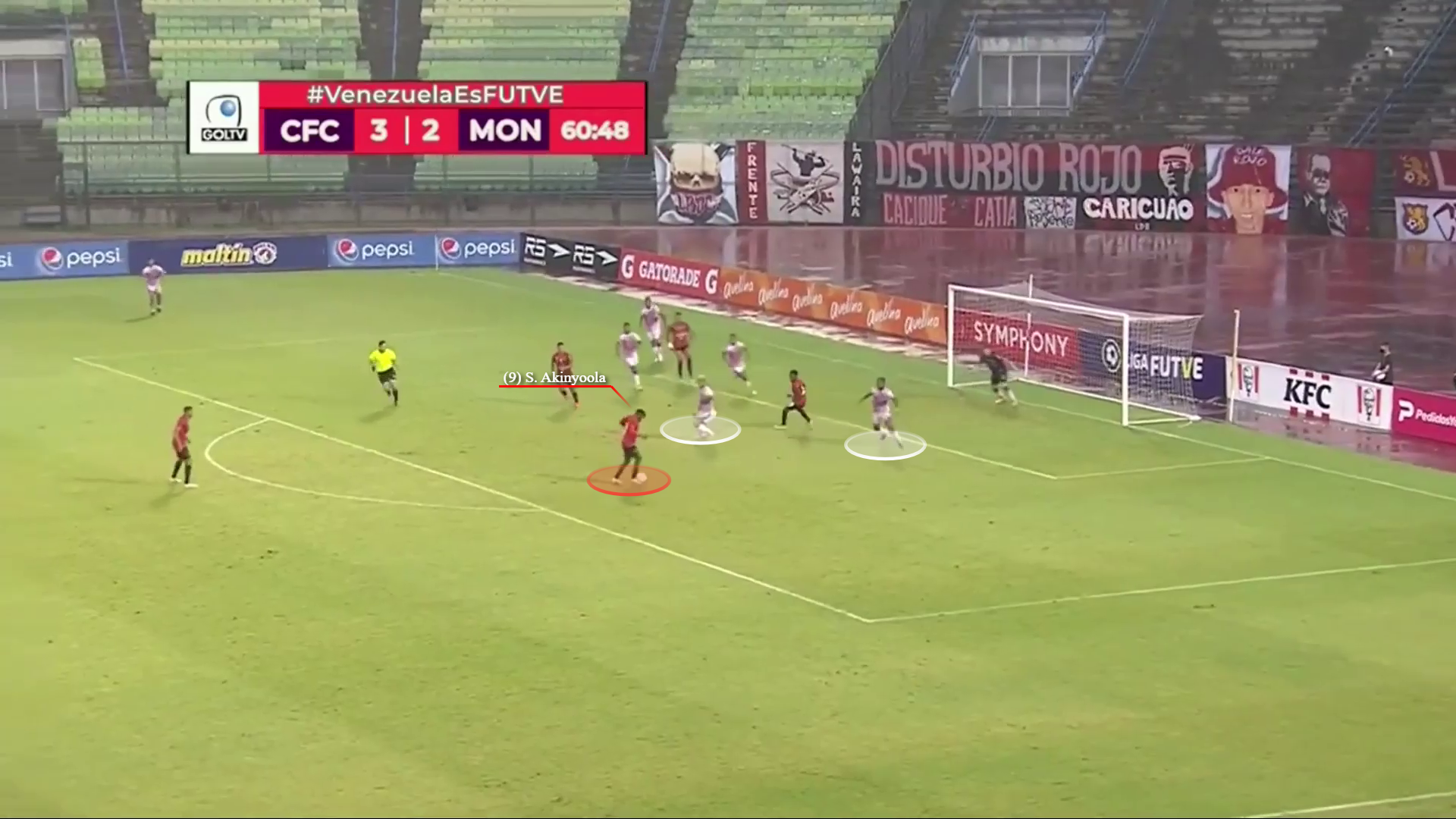
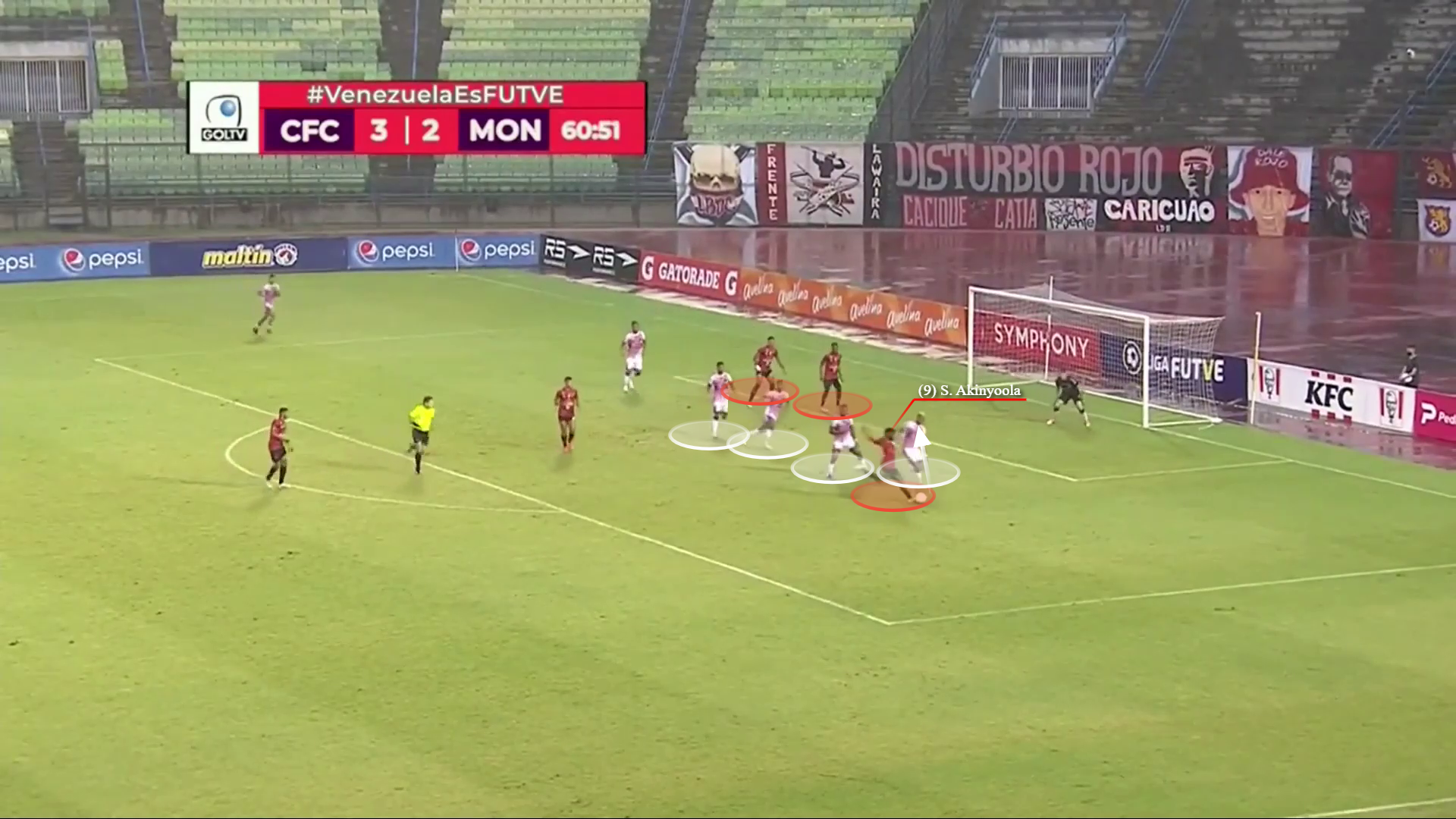
The latter can be seen in the image below, as here we Akinyoola attempt an awkward volley despite the difficult angle and the presence of not one but two teammates ready and available for a cutback and tap-in.
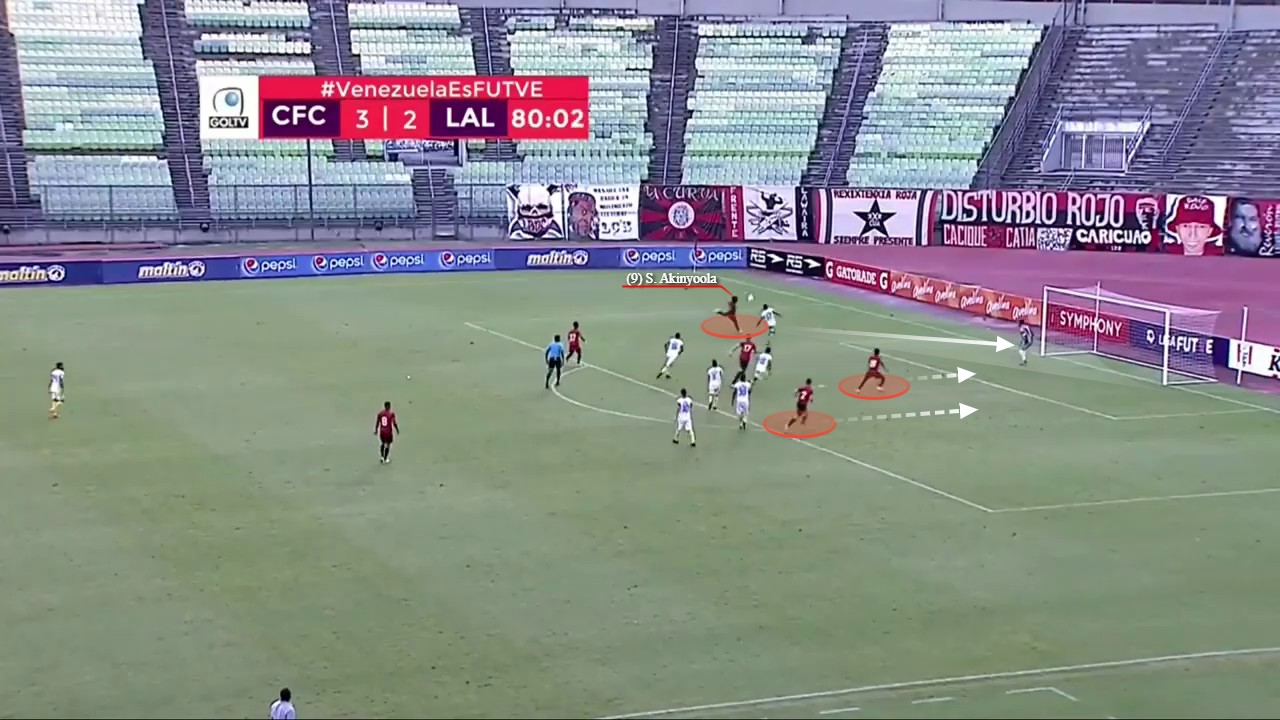
The graphic below shows Akinyoola’s expected and actual attacking output over the past two seasons. Interestingly, Akinyoola’s underlying numbers from his season in Slovenia are far superior to his current season in Venezuela; despite this, Akinyoola, in actuality, has been far more productive in Venezuela.
He has managed a net over-performance of xG and xA of 0.09, which is impressive but, more importantly, somewhat sustainable. Compare this to the incredible underperformance of the season prior, where he managed a -0.32 p90 figure, genuinely astonishing.
Despite this, he still managed a combined output of 0.41 goal contributions p90, which is fine, however when it’s expected to however around 0.73, which is nothing but disappointing.
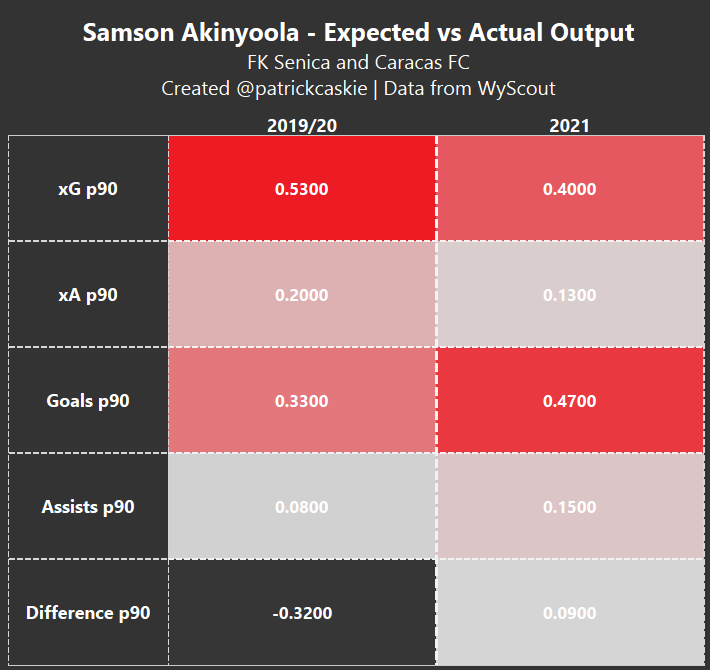
Role in Build-up, Link-up, and Chance Creation
We have talked at length about Akinyoola’s goalscoring nouse, however, he is not a single-faceted striker who just finishes off moves, rather he plays an integral and invaluable role in build-up, close and far from goal. The graphic below plots all of Akinyoola’s assists and shot assists from the 2021 season, and there are plenty.
Inherently actual assists are what get the headlines and will be used to support assertions of his well-rounded game, however, the abundance of shot assists to me is far more important, as a shot assist doesn’t rely on the finishing of a teammate in the same way an assist does.
As expected given his position and his role as a lone striker, a vast majority of Akinyoola’s assists and shot assists come from in and around the penalty box.
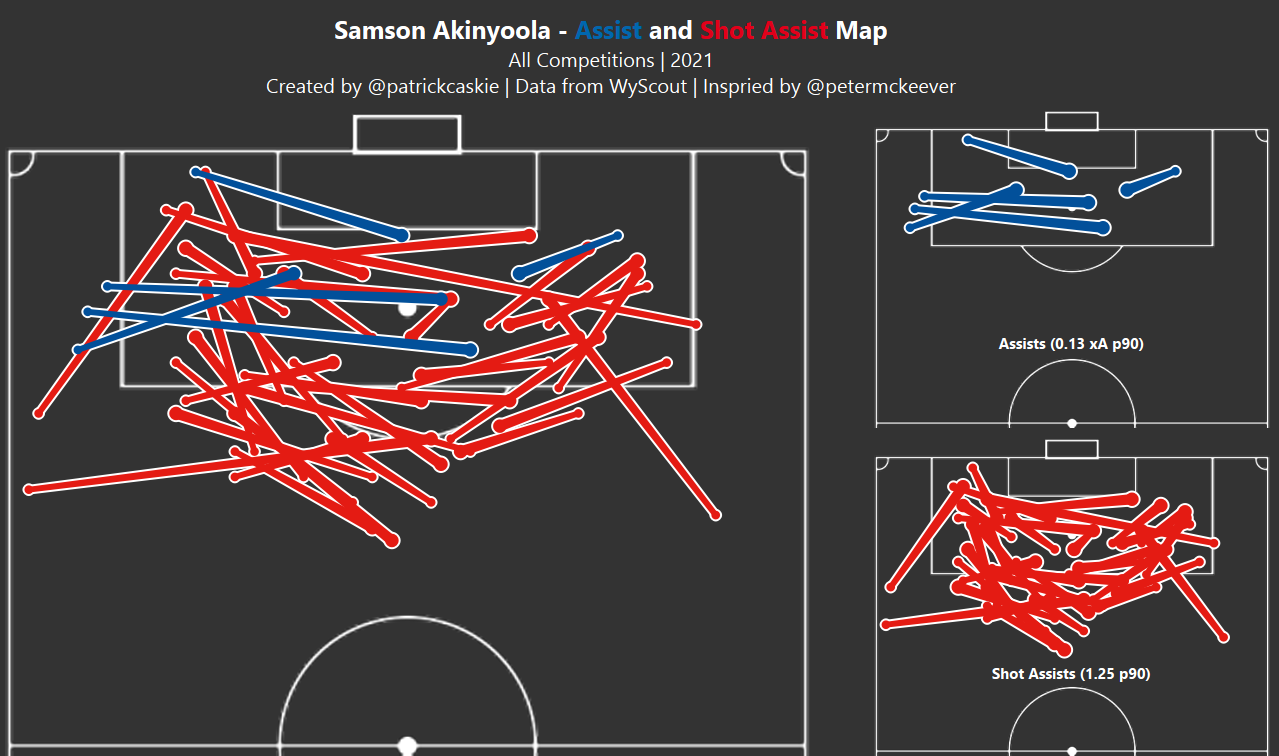
The most common assist/shot assist types within Akinyoola’s arsenal are either crosses or short layoffs whilst his back to goal, classical striker fare. The image below shows the former, as we see him play it wide to a teammate during a counter, a selfless and logical act that he should perform more often, which was discussed earlier.
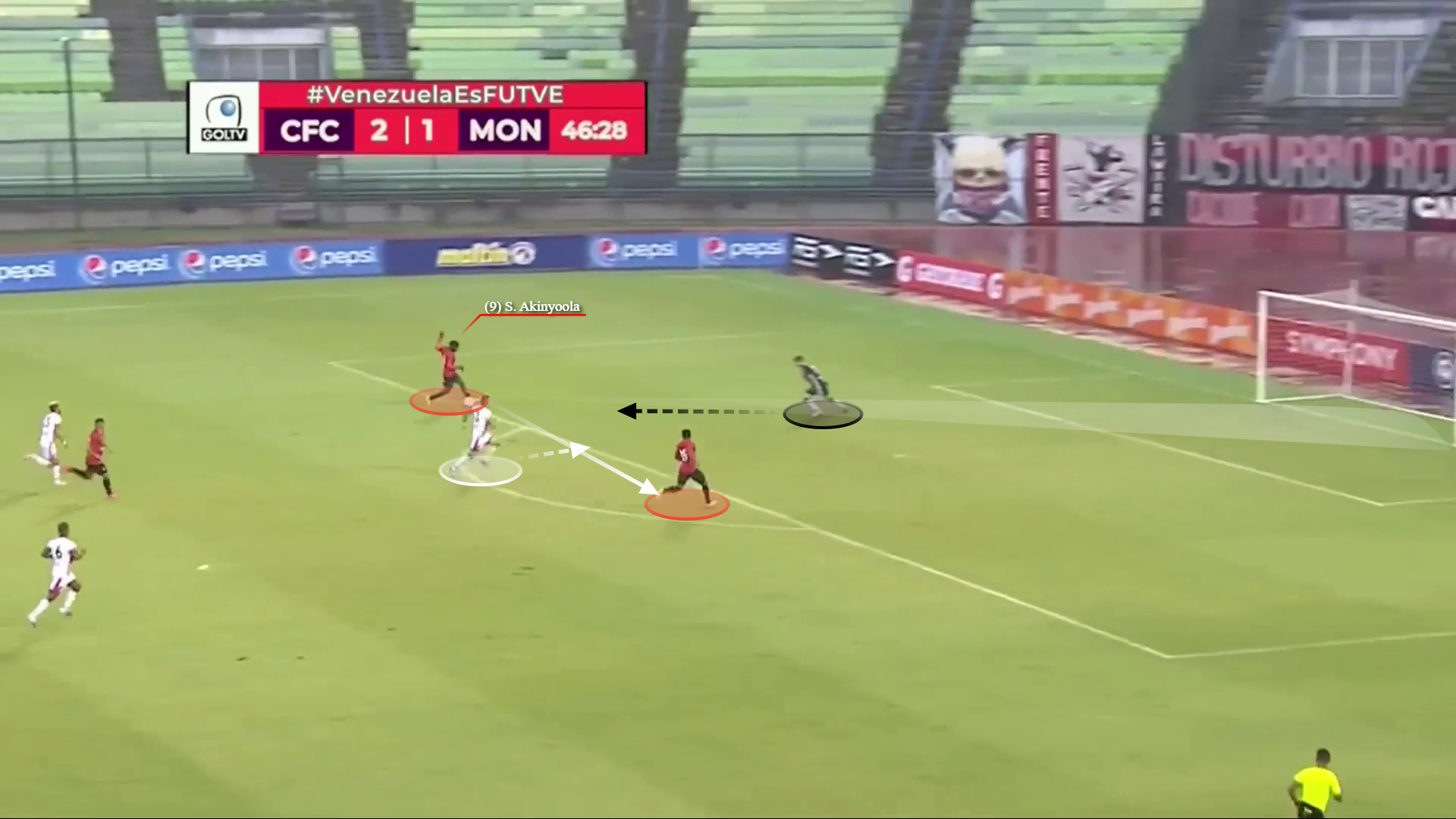
The previous example is pretty unspectacular and frankly falls in line with Occam’s Razor. A simple sideways pass requires minimal skill, and as a result, some may consider the merit of mentioning it, as anyone reading could likely replicate it.
However, it is still important to note his tendencies regardless of the difficulty of the act. The image below shows Akinyoola’s crossing ability in full, as he attempts and completes a far more difficult ball than the previous.
Here he receives the ball on the left-wing, shields the ball to buy some time before opening up his body and floating a pin-point cross to his on-running teammate, who has an easy time nodding in from such a cross.
He could have easily rushed this passage of play and attempted to forge a shooting opportunity; however, he remained patient and picked out the most appropriate route to goal, a sign of genuine footballing intelligence.
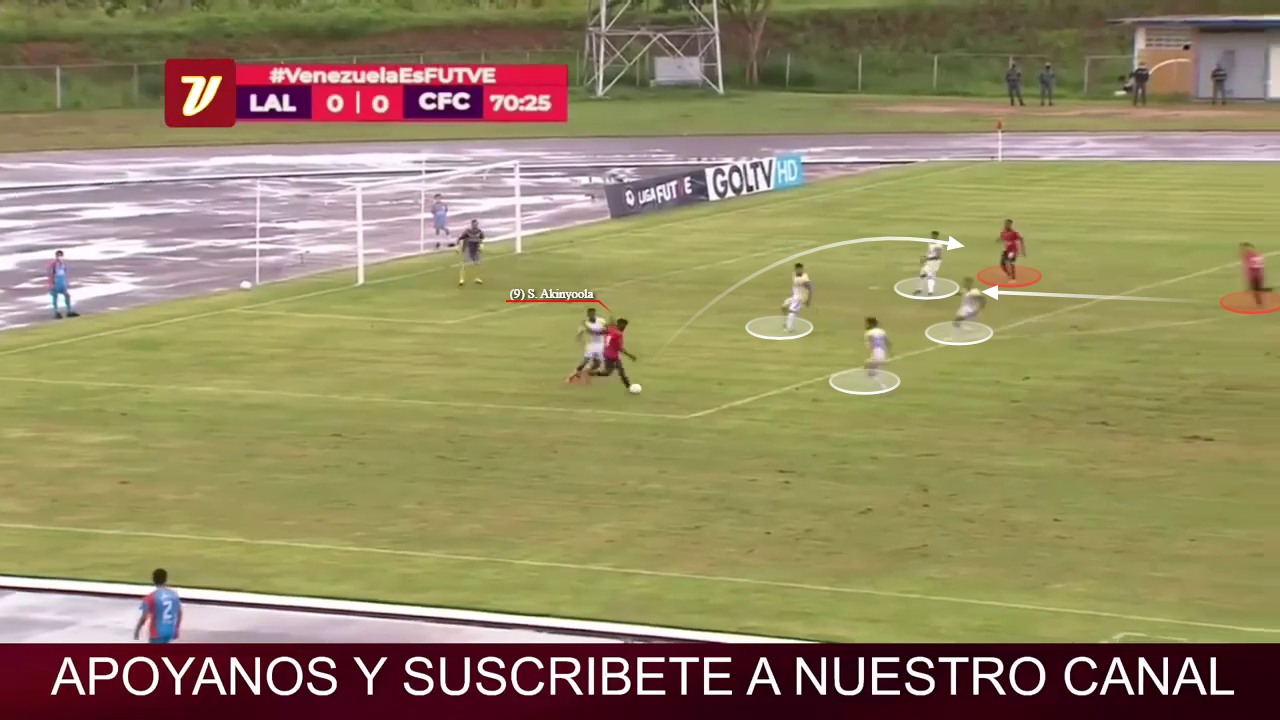
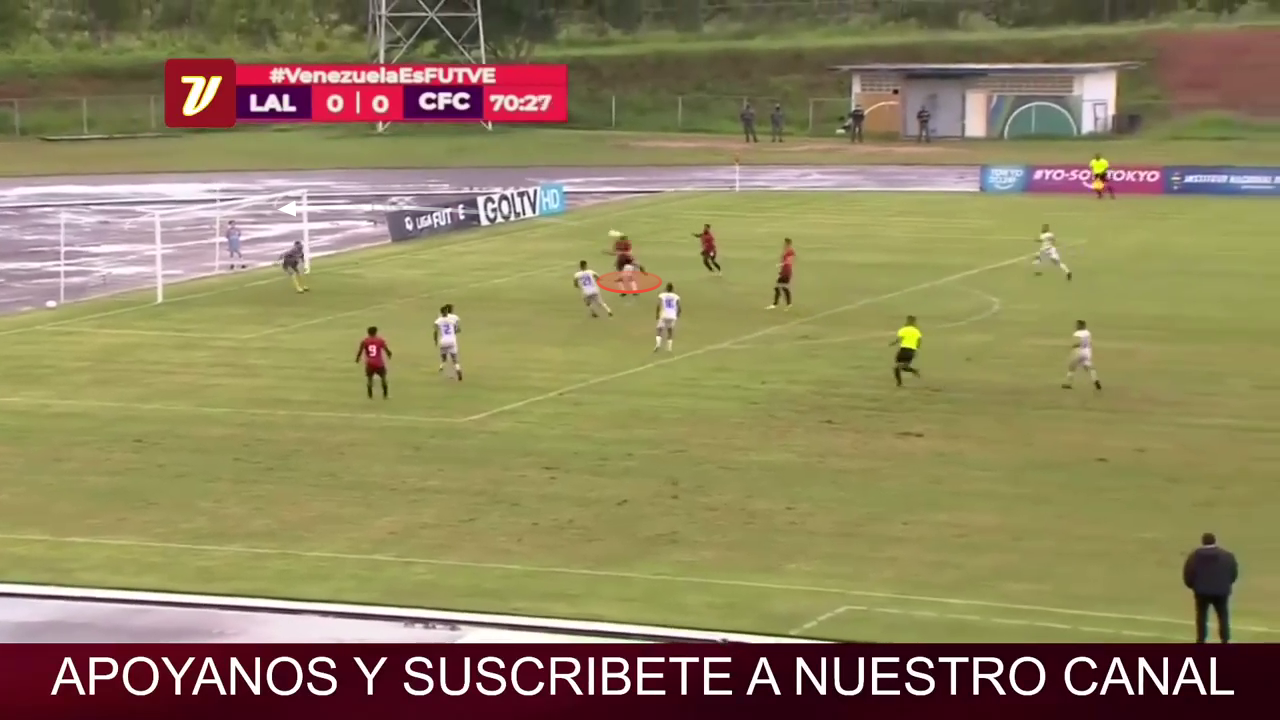
Naturally, Akinyoola attracts the defence’s attention, and as such, has a unique advantage, given the space he buys for his teammates. The image below shows this.
Here he has completely dragged the LB out of position, in turn creating a glaringly obvious avenue towards goal for his teammates to explore. His teammate obliges, and he finds with a simple through ball.

The other facet in which Akinyoola is utilised when close to goal is, as Caracas’s primary throw-in target. Akinyoola’s ability with his back to goal and generally impressive physique makes him an obvious choice.
The image below will be replicated several times each 90, as he is tasked with digging in close to the box, receiving the ball, and playing it back quickly to the thrower or a close teammate.
It is a unique characteristic that is inherently valuable. If used in a team with a set of more deliberate routines than Caracas, he could become a serious weapon.
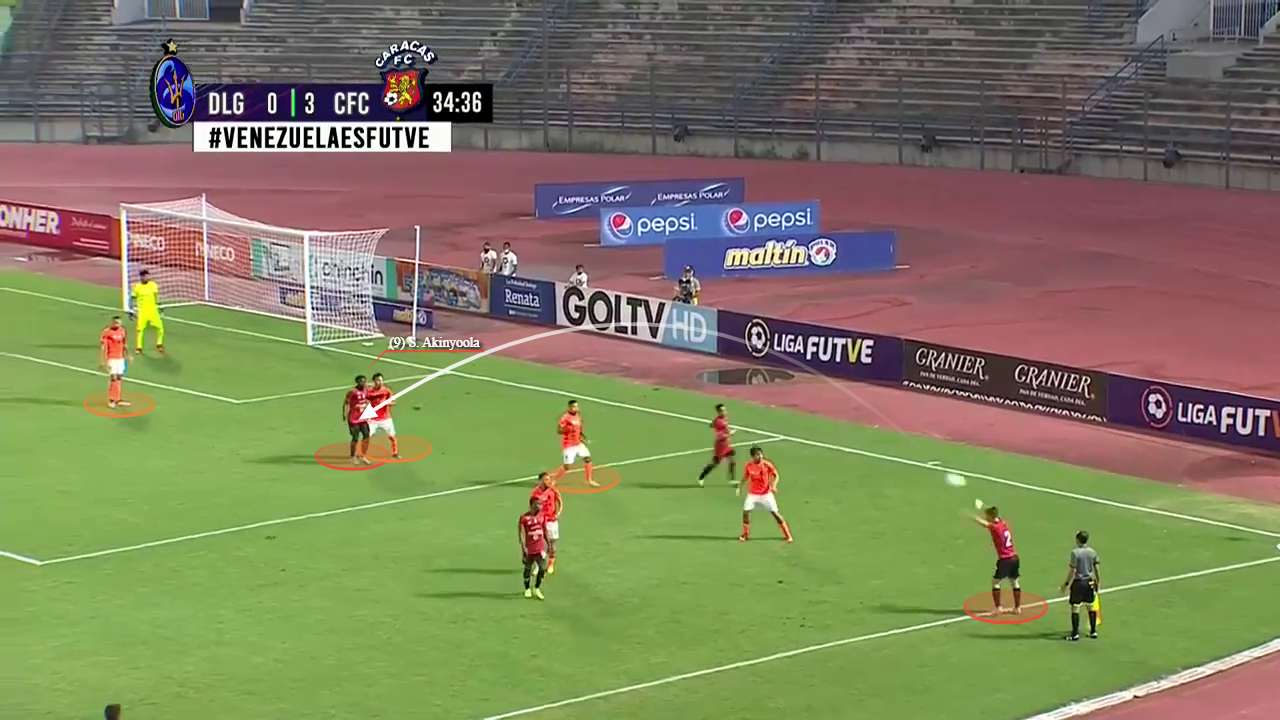
Like most strikers with Akinyoola’s physical profile, he is often tasked with coming somewhat deep to pick up the ball and play. The graphic below shows where Akinyoola has received passes this season, with the heatmap extending past the halfway line.
He isn’t a false-nine, but he does have the capabilities for periods to slip down and throw himself into the early stages of build-up.
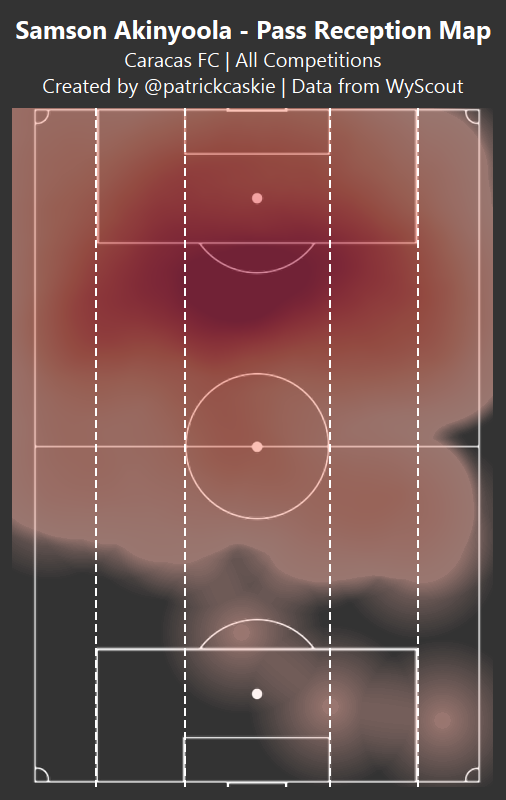
This can be seen clearly in the two examples below. In the first we see Akinyoola come deep and attract three defenders, one behind him and two laterally. Here he simultaneously picks up the ball and drags the opposition out of their shape, which makes it even easier for him to find a teammate in an advantageous position.
After receiving the ball, Akinyoola plays it first time to a teammate and then spins his defender offering a quick darting one-two. Despite being inside his own half the outlook is always focused on scoring, a pre-requisite for all elite-goalscorers.
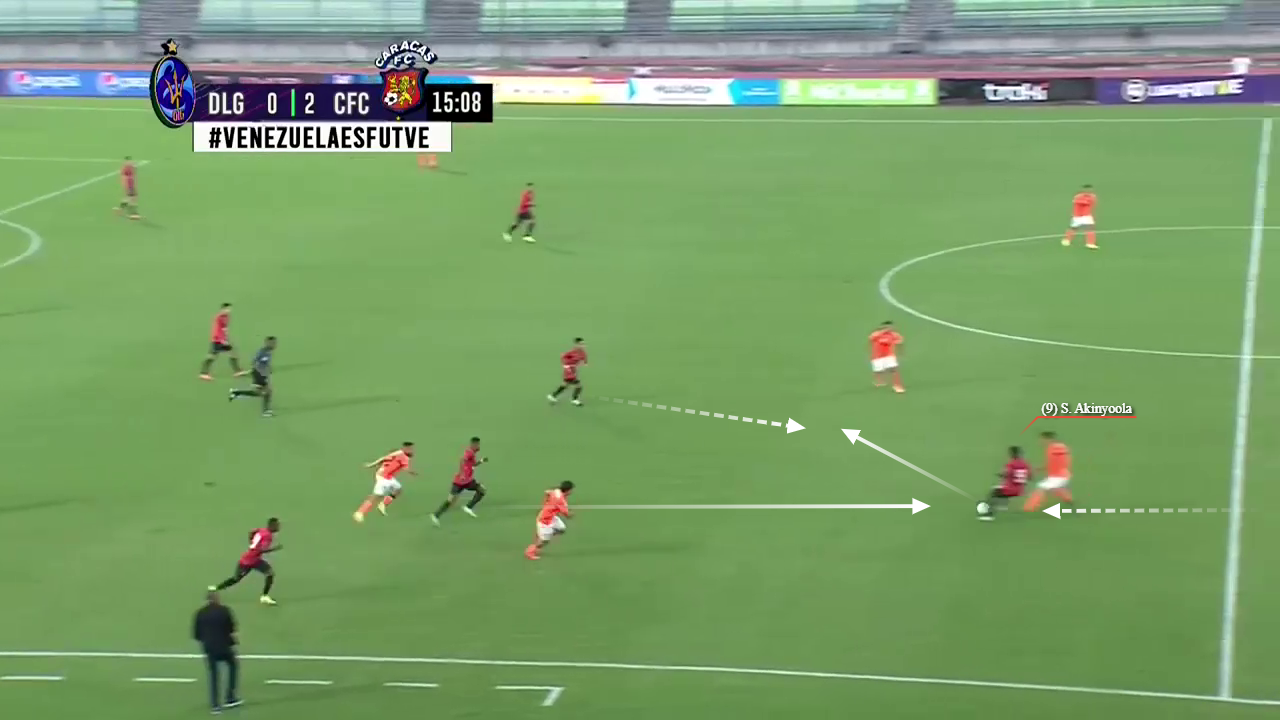
The second example below shows off Akinyoola’s decent passing range. Again he comes deep and attracts the oppositions CBs, before quickly turning.
This time instead of playing it simply back to a deeper teammate and offering a run, here he open’s up to his body and plays a pitched through ball, allowing his winger to take it in without breaking stride.
Don’t expect him to play this exact ball with pinpoint accuracy every time, as he is not that sort of player; however, it is valuable to note that he does have this in his bag.
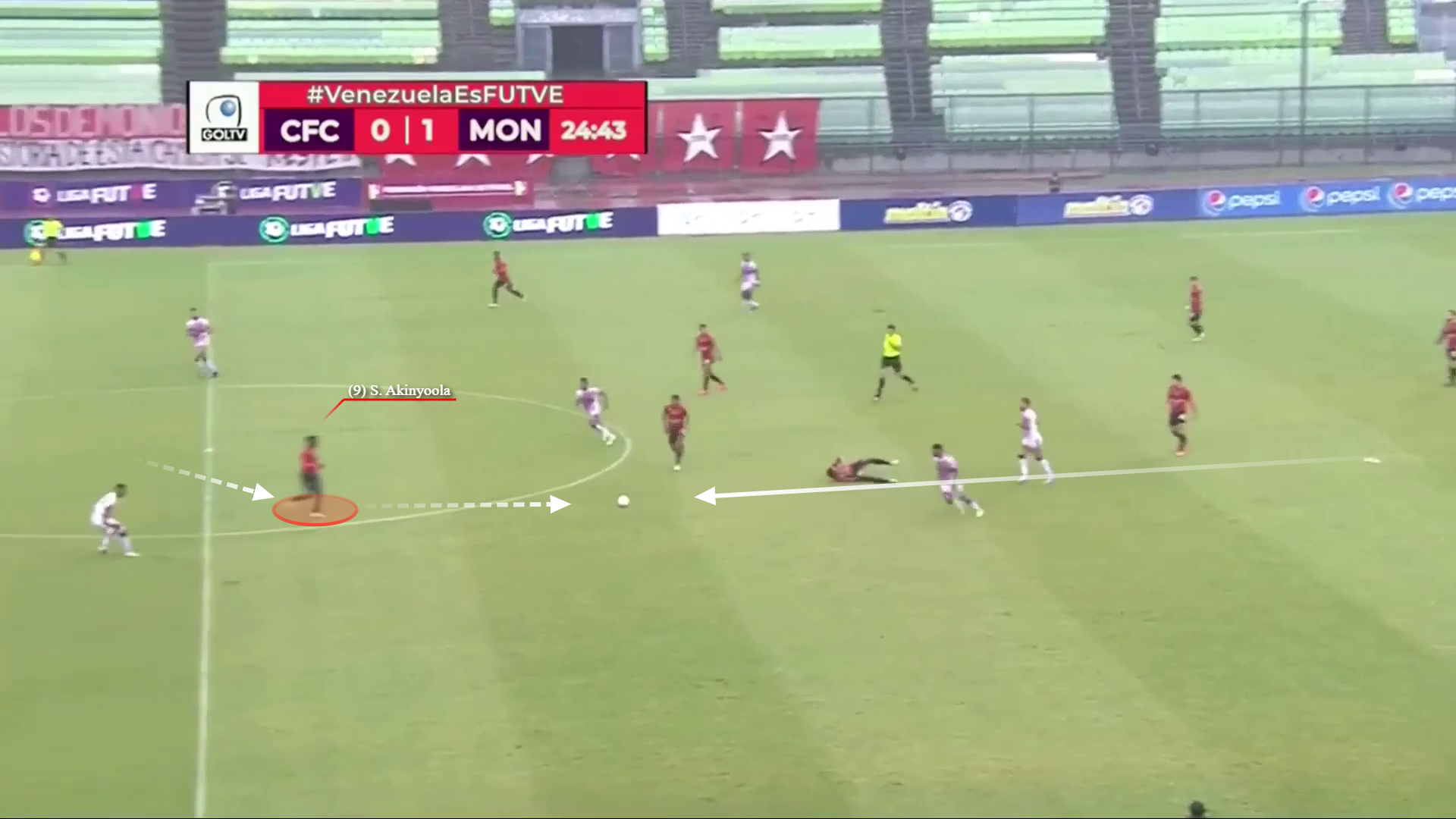

Ball-Carrying, Dribbling and Movement
Akinyoola is not a naturally aesthetic or flowing dribbler of the ball, though he makes up with pure effectiveness for what he lacks in appearance. I highlighted his movement abilities in the statistical overview, where he placed in the 70th+ percentile for all dribbling related metrics.
He does have a set of preferred moves and patterns which he often defers to, which for the most part are effective; however, he does carry some flaws which are limiting his ability to beat his man.
The movement map below, much like his heatmap and pass reception map, corroborates the idea that Akinyoola can be found pretty much anywhere in the final third.

If pushed, I would say that he has a slight penchant for the left side as the densest cluster can be found just in and around the left edge of the box.
The most common setup for an Akinyoola dribble is off the back of a diagonal run. The image below shows this perfectly. Akinyoola is played in by a teammate and judges the pace of the ball perfectly, knowing that he can allow his man to go line-side as the speed of the ball will play him in.
Typically, this will see him pick it up in a high and wide area, a key reason as to why that very same area is so densely represented in the image above.
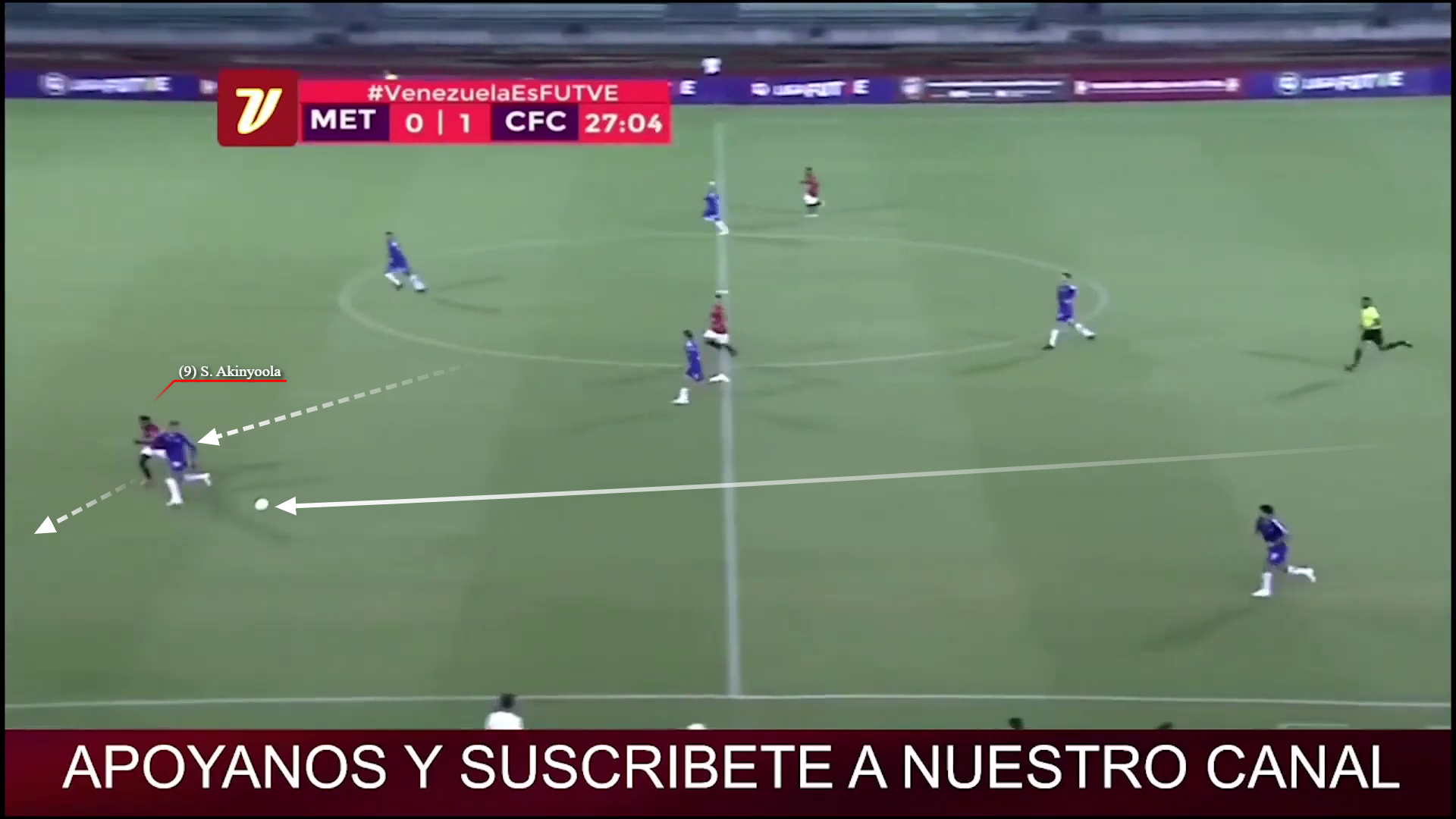
Once he finds himself in this sort of position, his go-to move is to move the ball from inside out with the outside of his boot. This allows him to establish a stable triple threat position, where he can move further, pass it, or, if close enough to goal, shoot. This is seen in the image below. Additionally, this move also buys him time as he waits for the cavalry to arrive.
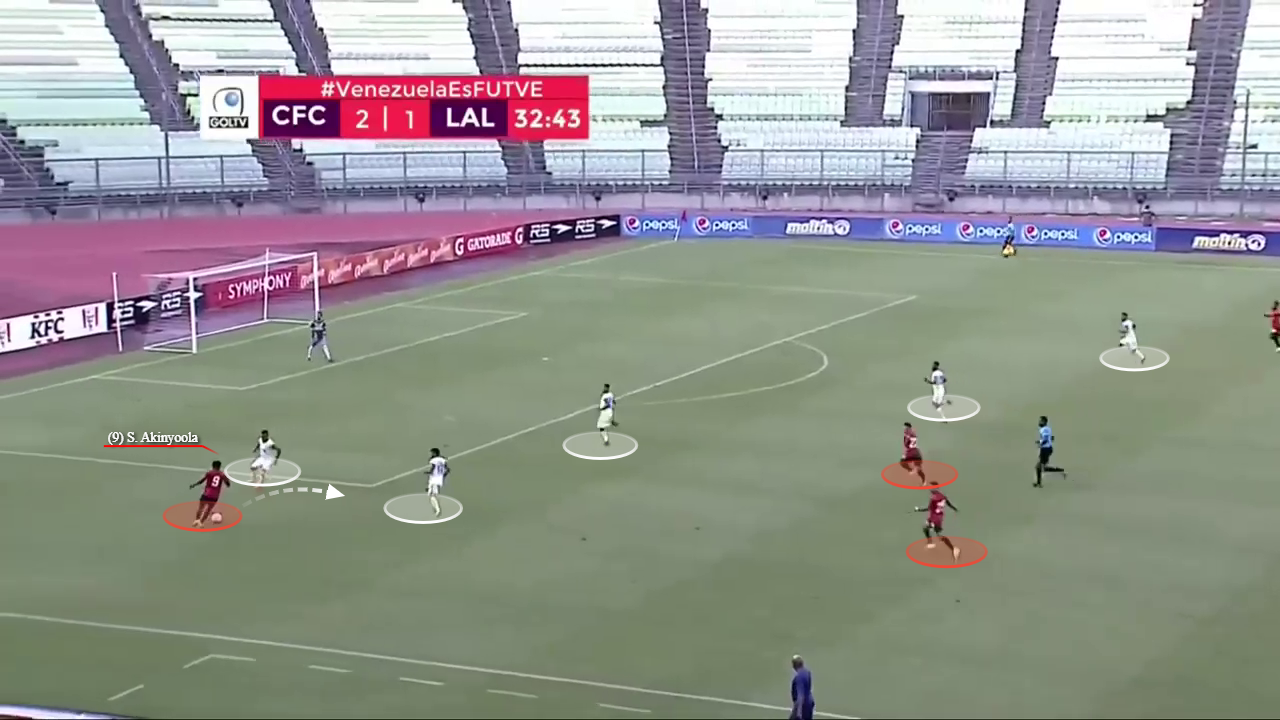
The only problem with this move is that often Akinyoola shows far too much of his chest to his marker. This allows his marker to plant his shoulder into his torso easily and, in turn, gain a substantial advantage over Akinyoola, and frankly, efficiently and legally push him off the ball. This should be a relatively easy fix, as he should drop his shoulder deeper to regain the natural advantage.
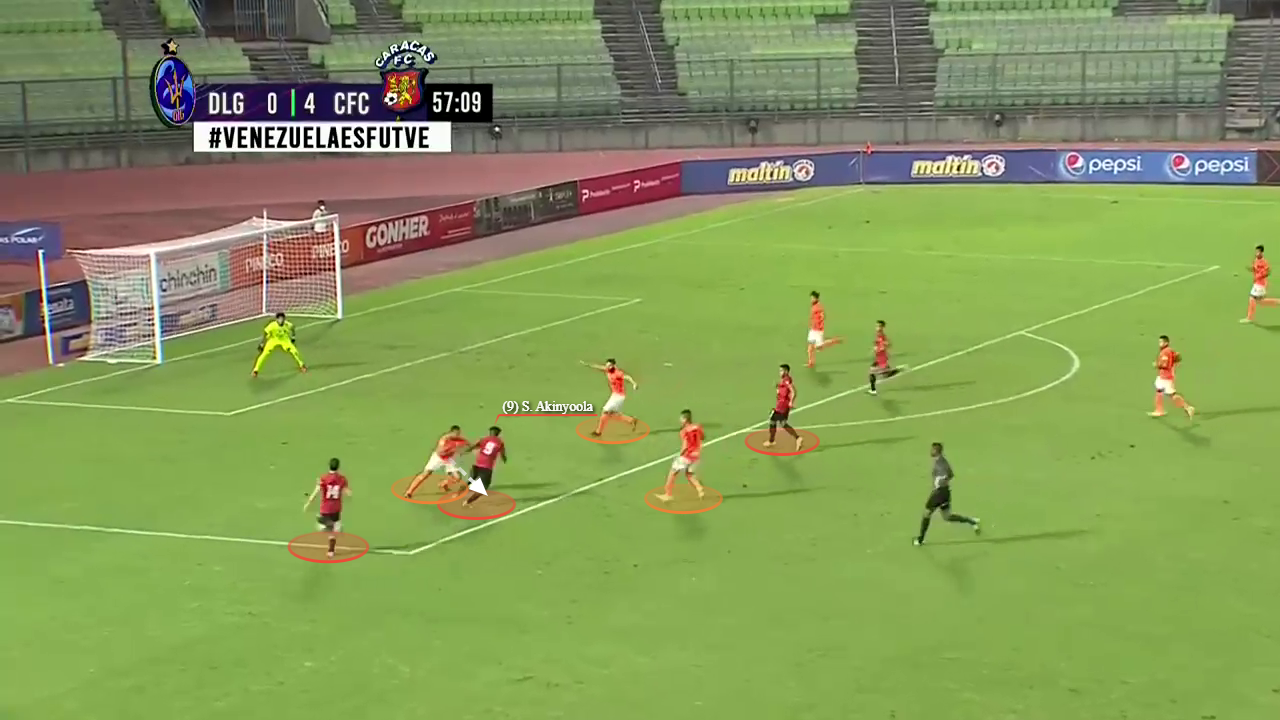
Akinyoola will never be a Josip Ilicic or Edin Dzeko, and as such, dribbling will never be his trump card. However, he has shown enough up to now for us not to worry about this facet of his game. His movement will beef up his all-around game as opposed to dominating it, a situation that I’m sure he and his coaches alike are content with.
Forecast and Comparisons
The forceful all-rounder has increasingly become in vogue within football at its highest level. Albeit playing at differing levels the two most pertinent comparisons I kept coming back to in regards to Akinyoola, where Alfredo Morelos and Terem Moffi.
Both like Akinyoola spent time destroying some of the worlds more obscure leagues in the form of Finland’s Veikausliga and Lithuania’s A Lyga. The comparison is not based solely based on career paths, rather the three can all to differing levels be described as a jack of all trades but masters of none, which in this instance is firmly a compliment.
The radars below show the output of the three are relatively similar, all maintaining healthy contributions in creation and goal-scoring. All three also share good physiques and can at times rely on this to bully defenders, however, their technical ability supersedes this, so any suggestions of them being purely brutes are wrong.
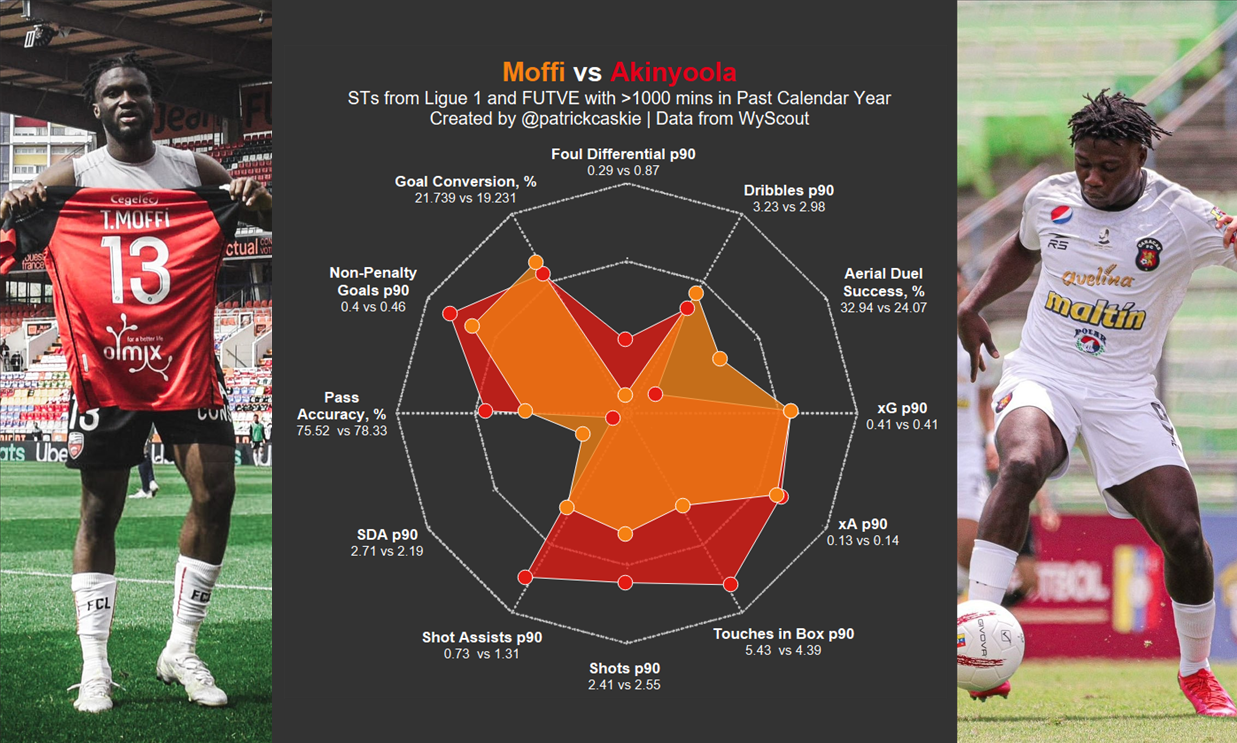

Both Morelos and Moffi got their moves, and are currently valued at £10.8m, proving to be outright successes financially and in a playing capacity for Rangers, Kortrijk and Lorient. Though I am not sure, Akinyoola will hit the heights that this pair have, taking the risk on the forward, which would cost around $1.5m.
According to Caracas-based football journalist Jordan Florit, this would be a logical and rational move for clubs in the likes of Turkey/Scotland/Belgium. Caracas FC has previous when it comes to exporting forwards to Europe.
Florit mentioned that “Last year, they sold striker Jeriel De Santis (18) to Boavista for 1m Euros, ten years ago they sold another forward, Ronald Vargas, to Club Brugge for around double that, so this price is not unrealistic”.
I expect Akinyoola to depart Venezuela sometime in 2022, whether that be to Europe, North America, or elsewhere in South America, I’m unsure. What I am sure about is that both Liga FUTVE and Akinyoola have benefitted from each other, and any potential success will go a long way in cementing the credentials of the vastly underrated league.
By: Patrick Caskie / @patrickcaskie
Featured Image: @GabFoligno / Pasionxeldeporte.com
